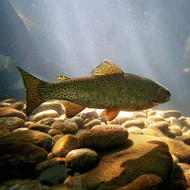
Promoting Fish Populations in Ponds & Lakes

Ponds are enjoyed by people for many different reasons, some people like to fish, some like to use it for family recreation and others have a pond because it came with the property. No matter what you use your pond for the ear-mark of a balanced, happy pond is a thriving fish population. You can build a sustainable environment for your fish by following a few simple guidelines.
Know Your Game Fish
Begin by knowing your game fish. You can do this by fishing the pond in all areas and jotting down what types and how many fish you catch and where you caught them. This can give you a baseline for what species you have in your pond and you can build habitats around those desirable species you wish to cultivate. Check with your region's fisheries and wildlife department for more information on what type of habitat those species prefer.
Develop an Environment
Now that you know the species of fish in your pond and have researched the environment in which they like to inhabit you can now begin to develop an environment that will help that population flourish. When fish are comfortable and do not feel threatened they will have healthier and more plentiful spawns. One important element that helps all fish species prosper is dissolved oxygen. Mother Nature is the only one that can change oxygen levels naturally but you can give her a little help by installing a pond aerator or floating fountain. As air bubbles circulate through the water column with an aerator or splash on the surface with a floating fountain, oxygen levels change dramatically.
Dissolved oxygen levels of 5 PPM (parts per million) help hatchlings, who are born on the bottom of the pond where there are lower oxygen levels, grow faster and helps keep the pond much cleaner throughout the season. Additionally, in the hot summer months, dissolved oxygen can swing wildly from morning to evening, a bottom aeration system or floating fountain will help maintain a constant, vigorous dissolved oxygen level.
Keep Some Natural Weed Growth
Fish love pond weeds, they provide shelter from predators and provide a natural nursery for eggs and baby fish, so it's a good rule of thumb to keep some natural weed growth. Aquatic weeds can also create a balanced ecosystem by naturally filtering the water by pulling in organics and utilizing them as food. That same material is often eaten by smaller, growing fish.
In addition to weeds, you can take physical measures to protect your fish by providing safe havens for them to live. This can be achieved by purchasing man-made, artificial habitats that not only help with predator cover but also offer a great place to fish since they naturally school there for cover.
Provide Additional Food Sources
Natural food sources already exist in your pond but it never hurts to provide additional food sources for your fish population. Stocking an ample supply of bait fish like fathead minnows, golden shiners or threadfin shad from your local fishery will help keep your fish thriving while maintaining their instinctual, predatory feeding process.
Balance the Fish Population
Now that you know how to establish your pond ecosystem you can choose what type of fish you want to cultivate. Balance is the key to establishing a strong fish population. We advise sticking to a ratio of three prey fish (like sunfish, bluegill or perch) to one predator fish (like bass) when choosing species. The number of fish added will ultimately depend on the surface area of the pond or lake.
A pond is a living, breathing ecosystem that can be fragile at times. Managing and tracking your ponds fish colonies is vital to maintaining a properly functioning ecosystem. With a little planning and some regular maintenance, you can create and sustain a thriving fish population.
